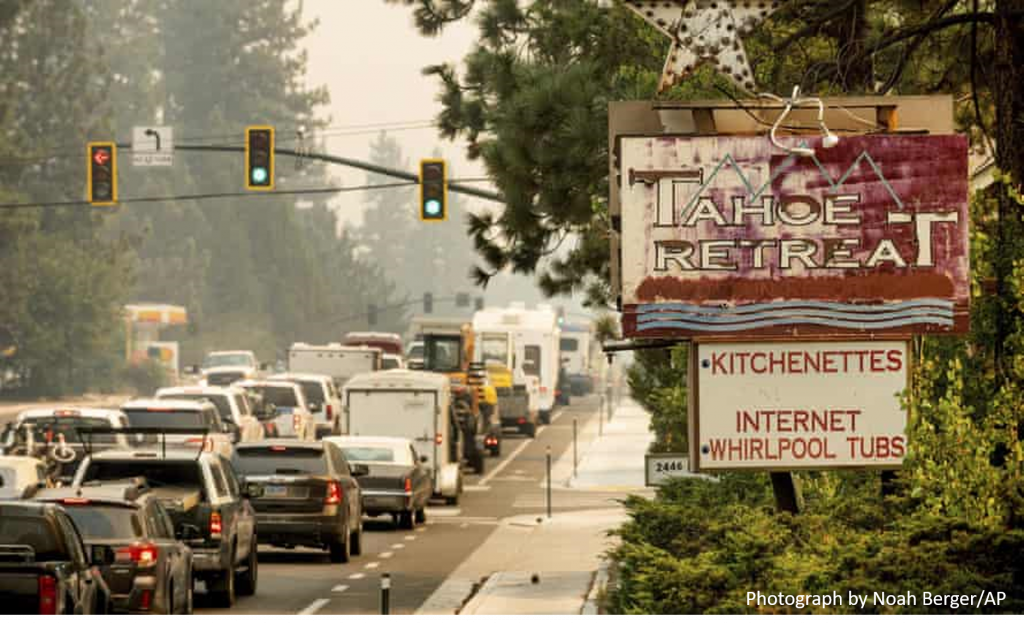
The streets of South Lake Tahoe are empty. No tourists, no scooters, no lines outside restaurants – only the choking smoke from nearby wildfires. Lake Tahoe is a magic sapphire in the Sierra Nevadas, the brightest jewel in one of nature’s finest crowns. The Caldor Fire threatens to turn it into a wasteland. Everybody has fled.
I last visited Lake Tahoe two years ago with my wife, daughter and son-in-law after a family wedding in Reno. I hadn’t seen it since I was a small child. The crowding was unexpected, as were the high-rise casinos. There were other signs of change, like a store that legally sold marijuana not far from our hotel. The crowds were a hassle, but not enough to eclipse the majesty of the lake and its surrounding mountains. We stayed at a lakeside lodging in a room with a balcony. The restaurants within walking distance were excellent. Now it’s all threatened by the inferno that the summer of 2021 has become.
According to the National Interagency Fire Center, 86 active fires have burned nearly 2.7 million acres in 11 states. Most of them are in the West and the largest are in California. Their names are as familiar as outlaws on wanted posters: Caldor; Dixie; Monument; Antelope; McFarland; River Complex. Trees burst into flame in California, Oregon and Montana. The smoke darkens skies as far away as New York and Chicago.
A Bible verse states “the heavens and earth that now exist are stored up for fire.” In my lifetime heaven and earth have burned with equal ferocity. Tahoe is heavenly. So are the Santa Catalina Mountains flanking Tucson to the north. Last year we watched with trepidation as the Big Horn fire topped nearby ridges and ashes fell on the foothills. Trails I had walked hundreds of times now climb through a blackened landscape. The stream in Finger Rock Canyon, where my dog and I played and wandered for years, was dry. In 2003 the Aspen Fire took our family cabin in Summerhaven, near the top of Mt. Lemmon in the Catalinas. The cabin literally vaporized; that’s how hot the fire was.
Burn scars are not limited to the mountains. The historic Pioneer Hotel in downtown Tucson went up in flames in late 1970, killing 29 people. Old Tucson, a movie set, amusement park, museum, and tourist attraction, tragically burned in a fire of unknown origin in 1995 that reduced more than forty percent of it to ash. A local gem, the Hidden Valley Inn, burned down the same year. From Old Tucson to Notre Dame, history reminds us that it is flammable.
But the fires in the mountains are the cruelest. They burn the innocent. The trees and animals did nothing to cause global warming. We humans, drunk on the juice of dead sauropods, caused it. For two centuries we drilled, filled and thrilled, our industry and autos quaffing the planet’s black blood like voracious vampires. The air became unbreathable, deserts grew, trees died, shrubs turned brown and glaciers melted away – and we didn’t care. But, as the old saying goes, nature bats last.
Humans inhabit the earth like mortgagors with a looming balloon payment who make no plans to pay it off. We were warned. For decades, scientists have told us that, unless we immediately reduce our reliance on fossil fuels, climate change and global warming could have catastrophic consequences. It will happen, they used to say. What do they say now? “It’s here.” The future inevitably blooms into the present. There is no longer any question that climate change will spawn historic fires, storms and floods. It also spawns massive human migration. Many of those seeking refuge at our southern border are there because global climate change has rendered much of the Northern Triangle countries uninhabitable. We are on course to suffer the dark reality that Malthus predicted: too many humans, too little food, too much death. We have sowed the wind; now we reap the whirlwind.
Perhaps there is a measure of poetic justice in humans having to suffer through the clean-up of the planetary mess we have made. But there is no justice when misery is inflicted on the innocent. When I read about the Caldor Fire and other prevailing infernos, I’m not thinking about our cabin, Old Tucson, or even South Lake Tahoe. As the burn scars grow, I think of:
The frightened deer and coyotes running from the flames.
The panicked beavers with no place to hide.
The birds choking blindly in flight, desperately seeking blue skies.
The rich brown soil that bakes into a deadly crust.
The wail of a dying moose.
The melancholy elegy of an evaporating waterfall.
The existential sadness of the trees.
© 2021 by Mike Tully
<<< YOU CAN READ / DOWNLOAD A PDF VERSION BY CLICKING HERE >>>

Thx for the excellent op-ed in the Sep 3 AZ Star. Your challenge to the local rightwing voice was really important. Also, it led me to your blog, and I plan to read through some postings.
Thanks and welcome!
Thx for the excellent op-ed in the Sep 3 AZ Star.